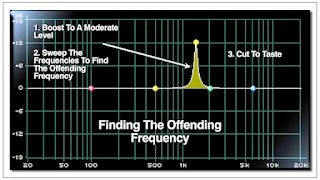"While it’s natural to believe that by adding some EQ here and there that you’ll make the instrument or vocal sound better, that’s not necessarily the case. There’s a very effective EQ technique called “subtractive equalization” that works by attenuating frequencies instead of boosting them. Many superstar mixers love this method because it makes the sound of the track more natural than if you boosted any of the frequencies. This is because every time you boost an EQ, there’s an slight amount of something called phase shift that’s added to the signal as a byproduct of the way an electronic equalizer works. By using subtractive equalization, you completely avoid this artifact. As a result, the track is better able to blend with the others.
Here’s how to use subtractive equalization:
1. Set the Boost/Cut control to a moderate level of cut (8 or 10 dB should work.)
2. Sweep through the frequencies until you find the frequency where the sound has the least amount of boxiness and the most definition.
3. Adjust the amount of cut to taste. Be aware that too much cut makes the sound thinner.
Alternately you can try a different approach.
1. Set the Boost/Cut control to a moderate level of boost (8 or 10 dB should work.)
2. Sweep through the frequencies until you find the frequency that really leaps out above all others. That’s the frequency to cut.
3. Adjust the amount of cut to taste. Be aware that too much cut makes the sound thinner.
There are two frequency ranges that are particularly effective when using subtractive equalization; from 400Hz to 600Hz and between 2k and 4kHz. The reason why 400Hz to 600Hz is chosen is because most directional microphones provide a natural boost in that frequency range because of the proximity effect brought about by miking an instrument or voice up close. Likewise, many mics that are known as good vocal mics have a presence boost between 2k and 4kHz. Cutting those frequencies a few dB (more or less as needed) can make the track sound much more natural than if you were to try to boost other frequencies instead.
These two problem areas usually crop up when you’re recording everything with the same microphone, since there’s a buildup in the those frequency areas as more and more instruments are recorded. By cutting a few dB from these frequency ranges you’ll find that the instruments sit better in the mix without every having to add as much EQ."
To read additional excerpts from this and other books, go to bobbyowsinski.com.
To read additional excerpts from this and other books, go to bobbyowsinski.com.
----------------------------------
You should follow me on Twitter for daily news and updates on production and the music business.
Don't forget to check out my Music 3.0 blog for tips and tricks on navigating social media and the new music business.



3 comments:
Good article :-)
However, I would say that, unless using a zero-phase EQ, any filtering will cause phase shift, whether boost (as correctly pointed out) or cut. Cutting the shift can be /less audible/, but it's still there, just because EQ/filtering works by superimposing a phase-shifted (fractionally delayed) signal (or signals) over the original signal, the sum of the signals produces what is heard. [apologies, I'm a nerdy DSP coder!]
I would also like to add to your article that paying attention to the surrounding sound, and judicious use of the same process you describe can help to get a vocal to sit in a mix. I've often found that small dips around 2K-5K on the more prominent supporting sounds can help give presence/air to a vocal without needed to touch the EQ of the vocal signal at all.
ATB
Duncan
since you say digital eq causes phase shit does analog eq cause phase shift as well?
This happens in all EQs to some degree, but it's worse in analog.
Post a Comment